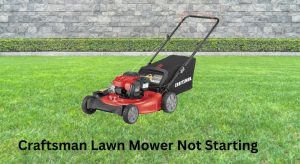Your Craftsman M110 lawn mower not starting can ruin your mowing plans fast. The good news? Most no-start issues have simple causes and quick fixes. Try this first: check the fuel level and freshness, ensure the spark plug wire is firmly attached, and press the primer bulb 3–5 times before pulling. Often, stale gas or a loose ignition wire is the quickest fix.
In this guide, you’ll get a complete troubleshooting process specific to the Craftsman M110 engine (most models use Briggs & Stratton or similar small engines). We’ll cover the most common causes, step-by-step fixes from basic to advanced, and preventive tips to keep your mower starting on the first pull. By the end, you’ll have your M110 running—or know exactly when it’s time to call a pro.
Common Causes of a Craftsman M110 Not Starting
- Stale or contaminated fuel (over 30–60 days old)
- Clogged carburetor or gummed-up jet from ethanol deposits
- Dirty or fouled spark plug, or loose plug wire
- Clogged air filter restricting airflow
- Safety switch not engaged (blade control/handle bail)
- Flooded engine from over-priming
- Low oil level triggering engine protection (on models with low-oil sensor)
- Blocked fuel cap vent causing vacuum lock
- Dirty carb bowl, stuck float, or bad needle valve
- Faulty ignition coil (rare)
- Sheared flywheel key (after hitting a rock) changing ignition timing
How to Fix a Craftsman M110 Lawn Mower That Won’t Start

Method 1: Quick Start Checks (5–10 minutes)
Diagnosing the Issue
Start with the easy wins. Many no-starts are due to basic issues you can spot in minutes.
Fix Steps
-
Verify safety controls:
– Squeeze and hold the operator/bail handle fully against the handlebar (the engine brake must be disengaged).
– If your model has a fuel shutoff, ensure it’s ON. -
Check fuel:
– If fuel is older than 30–60 days, drain and replace with fresh, ethanol-free gasoline if possible (E0 or E10 87+ octane).
– Add fuel stabilizer if you keep gas on hand. -
Prime and start:
– Press the primer bulb 3–5 times until you feel resistance.
– Pull the recoil starter with a firm, consistent motion. -
Check spark plug wire:
– Ensure the rubber boot is tightly pushed onto the spark plug tip. -
Air filter:
– Remove the air filter cover and inspect. If it’s clogged, remove it and try starting briefly. If it starts without the filter, replace the filter before running again. -
Check the gas cap vent:
– Try starting with the gas cap loosened a half turn. If it starts, the cap vent is blocked; replace the cap.
Testing
- If it starts and runs, you likely had stale fuel, a loose wire, or a venting issue.
- If it tries to start and dies, proceed to carb and spark checks.
Method 2: Fix Fuel System Issues (15–45 minutes)
Stale fuel and varnish are top causes for a Craftsman M110 not starting. This method addresses the carburetor and fuel delivery.
Diagnosing the Issue
- Symptom: No start or starts then stalls after a few seconds.
- Often caused by a clogged main jet, dirty bowl, or stuck float/needle.
Fix Steps
-
Drain old fuel:
– Use a siphon or remove fuel line at the carb inlet and drain into a container.
– Reconnect fuel line with the clamp secured. -
Clean/inspect carburetor bowl:
– Turn the fuel valve OFF (if present) or clamp the fuel line.
– Remove the 1/2-inch bolt (bowl nut) at the bottom of the carb and take off the fuel bowl.
– Note: On many Briggs-style carbs, the bowl nut is also the main jet; its tiny orifice must be clear.
– Clean the bowl and nut with carb cleaner. Use a thin wire or bristle to clear the jet hole and side ports—do not enlarge.
– Inspect the float for free movement. Ensure the needle valve moves freely and seals. -
Reassemble:
– Install the bowl with the rubber O-ring seated correctly.
– Tighten the bowl nut snugly (do not overtighten; typically 60–80 in-lbs).
– Turn fuel on and check for leaks. -
Add fresh fuel and conditioner:
– Fill with fresh gasoline.
– Optional: Add a small dose of carb/fuel system cleaner to help dissolve minor deposits. -
Prime and start:
– Press the primer 3–5 times; start the mower.
Testing
- Runs smoothly: fuel system was the culprit.
- Still a no-start: proceed to spark and ignition checks.
Method 3: Restore Strong Spark (10–20 minutes)
A weak or fouled spark plug is a frequent issue, especially after storage.
Diagnosing the Issue
- Remove the spark plug, reconnect the wire, and ground the plug threads to the engine block. Pull the cord and look for a bright blue spark. No spark or weak yellow spark indicates a plug/coil problem.
Fix Steps
-
Inspect plug:
– Correct plug for many Briggs-powered M110s: RJ19LM or equivalent (check your manual/engine code).
– Gap: typically 0.020–0.030 inch (0.5–0.76 mm). Most Briggs flathead: 0.030″. Verify your engine’s spec. -
Clean or replace:
– If fouled with carbon, clean using a wire brush and brake cleaner, then dry.
– If wet with fuel (flooded), dry the plug and let the cylinder air out 10 minutes with plug removed.
– Replace if the electrode is worn, cracked, or insulator is damaged. -
Reinstall:
– Hand-thread to avoid cross-threading.
– Torque: about 180–220 in-lbs (15–18 ft-lbs) for 14mm plugs.
– Push the boot on firmly until it clicks. -
Check ignition coil air gap (if no spark persists):
– Remove the blower housing (pull-start cover).
– Inspect coil to flywheel gap: set to 0.010–0.014 inch using a business card or feeler gauge.
– Ensure kill switch wire isn’t shorting to ground.
Testing
- Strong spark and start achieved: problem solved.
- No spark: ignition coil may be faulty; consider replacement.
Method 4: Air and Safety Systems (10–25 minutes)
Air restriction or a safety interlock can prevent starting.
Diagnosing the Issue
- Dirty foam/paper filter, stuck choke, or operator presence control not engaging.
Fix Steps
-
Air filter service:
– Foam pre-filter: wash with warm soapy water, squeeze dry (do not wring), lightly oil, squeeze out excess.
– Paper element: tap gently to dislodge dust; replace if clogged or oily. -
Choke/primer function:
– Observe choke plate when priming or switching choke: it should fully close for cold start and open after start.
– If the choke doesn’t move, check linkage and springs for binding or disconnection. -
Blade control cable (bail):
– Ensure the cable fully disengages the engine brake and activates the ignition.
– Adjust cable tension at the bracket if the lever doesn’t pull fully. -
Fuel cap vent:
– If engine starts then stalls after a minute unless cap is loose, replace cap.
Testing
- Attempt a cold start; if it runs, you solved an airflow or safety interlock issue.
Method 5: Advanced Mechanical Checks (30–60 minutes)
If you still have a Craftsman M110 lawn mower not starting, dig deeper into timing and compression.
Diagnosing the Issue
- Sudden no-start after hitting a rock or curb often indicates a sheared flywheel key (timing off). Lack of compression can indicate valve issues on overhead valve (OHV) engines.
Fix Steps
-
Flywheel key inspection:
– Remove the recoil cover and flywheel nut.
– Use a strap wrench to hold the flywheel; do not wedge screwdrivers in fins.
– Remove the flywheel using a proper puller. Inspect the aluminum key in the crank/flywheel slot.
– If the key is sheared or offset, replace with the correct Briggs key and re-torque flywheel nut per spec (often 55–65 ft-lbs; check your engine model). -
Compression and valve check (for OHV engines):
– Remove valve cover.
– Rotate engine to compression stroke and check valve lash.
– Typical lash: Intake 0.004–0.006 in, Exhaust 0.005–0.007 in (confirm for your specific engine).
– Adjust with feeler gauges if out of spec.
– Replace valve cover and gasket if needed. -
Carburetor replacement:
– If repeated cleanings fail, consider a replacement carburetor matched to your engine’s model/type code. Many Craftsman M110s use affordable bolt-on carbs.
Testing
- Reassemble and test starting. If timing or valve lash was the issue, you should see immediate improvement.
How to Prevent Future Starting Issues
- Use fresh, top-tier gasoline; avoid letting fuel sit more than 30 days.
- Add fuel stabilizer at every fill if you store gas.
- Run the engine dry or shutoff fuel and run until stall before winter storage.
- Replace the air filter each season; clean foam pre-filters monthly during heavy use.
- Replace spark plug annually or every 100 hours.
- Change engine oil every season or 25–50 hours, depending on your model.
- Keep the deck underside clean to reduce load and improve airflow.
- Store the mower in a dry, covered location.
Pro Tips
- Prime smart: Over-priming floods the engine. If you smell gas and the plug is wet, open the throttle (if equipped), hold bail, and pull with choke off. Let it sit 10–15 minutes.
- Carb jet cleaning: The tiny side hole in the bowl nut clogs most often. Use a single bristle from a wire brush to clear it, then rinse with carb cleaner and compressed air.
- Check kill switch: Disconnect the thin kill wire from the ignition coil. If you get spark with the wire off, the stop switch/cable is shorting to ground.
- Keep a tune-up kit: Air filter, spark plug, and carb bowl gasket on hand—cheap and saves a trip mid-mow.
- Fuel filter: Some M110 variants have an inline filter. Replace annually; ensure flow direction is correct.
- Pull-start technique: Short, fast pulls with the bail fully engaged are better than long, slow pulls.
- After washing: Avoid direct water into the air filter or carb; moisture leads to hard starts. If it gets wet, dry the filter and let the mower sit in the sun before starting.
When to Call a Professional
- No spark after new plug, correct coil gap, and kill-wire isolation—coil likely failed.
- Repeated carb clogs even after cleaning—ultrasonic cleaning or carb replacement needed.
- Sheared flywheel key replacement if you lack a puller/torque wrench.
- Low compression or valve issues you’re not comfortable adjusting.
- Persistent fuel leaks from bowl or line fittings.
What to look for in a service provider:
– Small-engine certification and experience with Briggs & Stratton.
– Clear diagnostic fee and turnaround time.
– Uses OEM parts or reputable aftermarket equivalents.
Typical costs (varies by region):
– Basic tune-up: $60–$120
– Carb clean/rebuild: $70–$150
– New carburetor install: $80–$180 parts/labor
– Ignition coil replacement: $90–$160
– Flywheel key service: $80–$150
Warranty considerations:
– Newer Craftsman mowers may have limited warranties on engine components; check your model and keep receipts. Using non-OEM parts typically doesn’t void warranty but damage from improper installation could.
FAQ
Q: What kind of gas should I use in a Craftsman M110?
A: Use fresh 87+ octane unleaded gasoline, preferably ethanol-free (E0). If using E10, avoid storage over 30 days and add stabilizer immediately after purchase.
Q: How many times should I press the primer bulb?
A: Typically 3–5 firm presses. If the temperature is cold, you may need one or two more. Over-priming can flood the engine.
Q: How often should I change the spark plug?
A: Inspect each season and replace every 100 hours or annually, whichever comes first. Use the plug type specified by your engine manual (e.g., RJ19LM/ J19LM or equivalent) and set correct gap.
Q: My mower starts then dies after 10–30 seconds. Why?
A: Commonly a clogged main jet or blocked fuel cap vent. Clean the carb bowl and jet, and test with the gas cap loosened. Also check for a clogged air filter.
Q: The starter rope is hard to pull. Is that related?
A: Possibly. Check for a stuck blade due to built-up grass, a partially engaged brake, or a sheared flywheel key after impact. Always disconnect the spark plug wire before working near the blade.
Q: How do I know if the engine is flooded?
A: Strong fuel smell, wet spark plug, and no start after repeated primes. Remove and dry the plug, open choke (if equipped), hold bail handle, and let the cylinder air for 10–15 minutes before retrying.
Q: Does low oil prevent starting?
A: Some engines have a low-oil shutdown. Check oil on a level surface; fill to the correct mark. Overfilling can also cause hard starts or smoking.
Q: What’s the correct spark plug gap?
A: Many Briggs-powered mowers use 0.030 inch. Verify with your engine model number for exact spec.
Alternative Solutions
Sometimes, repeated carb issues or old fuel systems make maintenance a headache. Consider these options.
| Solution | Pros | Cons | Best For |
|---|---|---|---|
| Replace carburetor with OEM | Reliable, quick fix for persistent clogging | Higher cost than cleaning | Users wanting a one-and-done repair |
| Switch to ethanol-free fuel | Reduces varnish and corrosion | Higher price, availability varies | Seasonal storage, infrequent use |
| Add in-line fuel shutoff valve | Easy winterization, prevents bowl gumming | Minor install required | DIYers storing mower for months |
| Annual professional tune-up | Comprehensive check and adjustment | Ongoing cost | Users wanting guaranteed reliability |
Get Your Craftsman M110 Working Again
Following this guide, you now have multiple solutions to fix your Craftsman M110 lawn mower not starting:
– Quick checks for fuel, spark plug wire, primer, and air filter
– Fuel system cleaning, carb bowl and jet service
– Spark plug replacement and ignition coil gap checks
– Safety controls, choke linkage, and gas cap vent fixes
– Advanced timing (flywheel key) and valve lash adjustments
Don’t let a no-start derail your yard work. Work through the steps in order—most mowers fire up after fresh fuel, a clean jet, and a good plug. If you hit a wall, a pro can finish the job quickly.
Have you tried these methods? Share your results in the comments below, and let us know what finally got your Craftsman M110 running. Found this helpful? Bookmark it for your next tune-up. With these tips, you can avoid a Craftsman M110 lawn mower not starting ever again.




